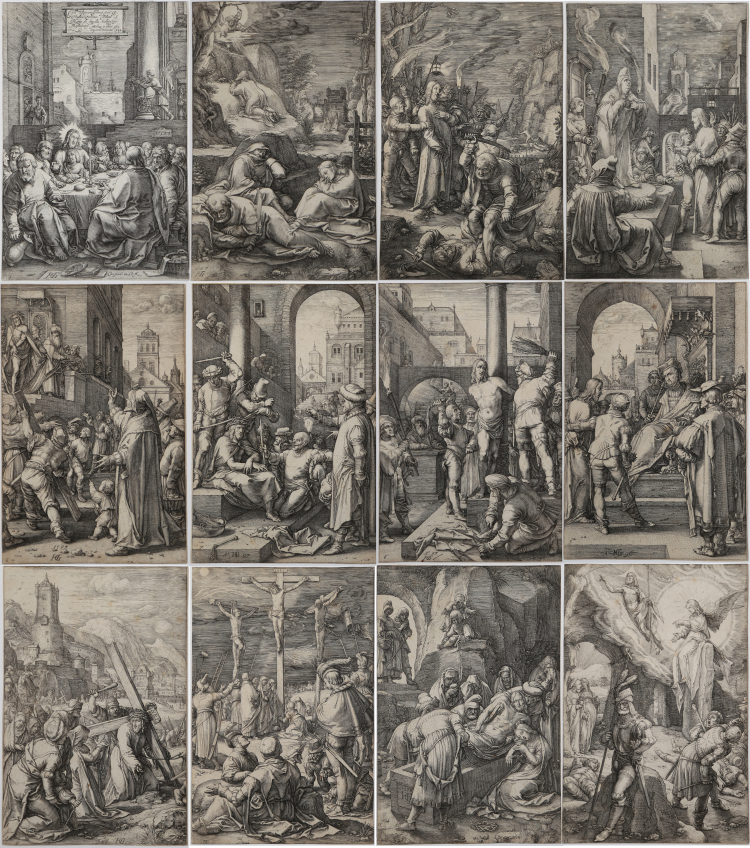Easter 2025
This is an Easter sermon
It begins in a strange place.
With an empty tomb. Those who find the tomb called liars, or more politely in Luke, “women who were telling an idle tale…” In that tale there’s an idea that maybe it’s true…Jesus is risen.
This is how we know it’s true. There’s a long list of people to thank this morning. Our readers. Our altar guild. Our Facilities Manager. Our musicians. Our music director. Our administrator. Our 1,2, 3, 4, 5, 6 acolytes. and of course, Mr. Brown our acolyte trainer. We thank them not just for doing their jobs but for acting out that greeting I turned into a sticker,
“Speak words of hope. Be human in this most inhuman of ages. Gaurd the image of one another. You are the image of God.”
We need the particularity of your your gifts. We need your image of God—the fulness of your humanity. When you are the fullness of you; not an imitation of others think you should be we begin to understand what the gospel writer meant when he says, Jesus said, “I am the way, the truth, the life.”
This particularity doesn’t start out this way… it begins in Jesus adult life with the first disciples saying, Jesus of Nazareth. Nazareth. What good can come from there?
Come and see…
And so it is they come. Jesus makes people proud to be who they are, not wishing they were anyone else. We should all be proud to be where we’re from
Who’s from Jersey City? Clap. Maybe even shout. How about yell, “Hosanna.”
There’s just one problem with this, when pride comes from here—your head—it leads straight to here—your head. Then the next step is, “Gee, I have a better idea…crucify him.”
I’m a kid from Indiana. It’s taken me decades to want to admit that.
Perhaps one of the reasons I’m hesitant is that I grew up in the era of another Hoosier Ryan White…a child who died of aids after a blood transfusion; but not before everyone treated him terribly. This makes me sensitive not just to the beauty of the world but the outrage.
What’s the bumper sticker, “if you’re not outraged. You’re not paying attention “
The late Indianapolis Indiana born writer Kurt Vonnegut didn’t like Christians.
His most thoughtful critique is a 2-sentence summary. “Believing in Jeus is fine. Just don’t say believing in him is a way to win.”
This is why I agree with Kurt.
Althea, Patrice, Velma, and anyone else who has worked at summer camp at this church you may understand. You’ve spent decades working with children. You have probably done so because someone worked with you. Someone shared words of encouragement likely accompanied by hymns that reminded us of, “Jesus and his love…”
Yeah. Me too. Nearly every time I’ve given back and worked with kids I’ve also worked at churches. So, I’ve told a lot of Bible stories. And, if I’m to be honest about it, sometimes it feels like the stories are fairy tales.
Once upon a time there was a baby born beneath a dancing star. Wise men came to visit bearing gifts and angels in the sky sang song of joy.
Once upon a time there was a man who had so much faith that he walked on water.
Once upon a time 5,000 hungry people were fed with just two loaves of bread and five fish.
Sometimes it feels like stories of the bible are all about rainbows and kindness and love--but not Holy Week. Not with this line,
“They broke their legs…”
Little men with scars on their face, long hair, skinny arms and something to prove took clubs and hammers and began beating on the legs of the thieves and murderers who were sentenced by the court to die. They beat them until their legs broke.
That’s a lot of violence.
And even when you add the word Jesus to the story, as people who work with kids are sometimes used to doing, it doesn’t get better.
“And when they came to Jesus they didn’t break his legs…he was already dead.” So instead one of the big ones, with hair on his back, and sweat stains on his clothes took a spear and pierced his side. Blood rushed out, water rushed out.
This isn’t the story that we usually tell our children that we tend to tell each other--it’s too violent. Many have said that a telling of the gospel that emphasizes the nurturing aspect of God serves as a counterpoint to a vengeful and violent God that is sometimes spoken about by fundamentalists.
I agree.
There are too many who have heard words of faith as words first of judgment.
Yet, I think that we’ve got to tell stories of violence and disappointment too. Because, if we only tell the stories of love, we miss a major part of the gospel and it begins to sound like just a fairy tale or a fable.
This is a true story.
One of the places that I worked with kids was in Indianapolis, Indiana. The church was in a neighborhood full of children. In fact, it was across from Short Ridge Elementary School where decades earlier the writer Kurt Vonnegut had been a student. When I arrived, the neighborhood was no longer a place where famous writers lived or sent their children to school. I was there in the mid 1990’s. The community was just beginning to recover from an epidemic of crack cocaine. Neighbors were trying to recover from the infusion of crime and violence that came with addiction. I came because I wanted to be, as others had been for me, an example of love. I wanted to tell the story of Jesus, and his love.
The way I told the story at the time was in the costume of long blonde-haired hippie wearing tye-dyed shirt t-shirts and Birkenstock sandals.
I talked with the kids about love a lot.
I talked about mutual respect and tolerance.
I talked about non-violence and education.
And one day in the middle of all this love and tolerance, this one kid, last name, Easter, real name real story, began acting out. He was so bad that I finally lost it—and this is something you shouldn’t do, if you’re looking to be an example of love and tolerance—I grabbed him by the arms and I shook him.
“Easter” I said, “what in the hell is wrong with you?”
“I don’t know,” he said.
“I guess I’m sad.”
What could this kid possibly be sad about I thought. I brought in tye-dyed t-shirts yesterday.
What could this kid be sad about I thought I was playing music on the radio and encouraging to the latest grooves of Eryaka badu.
What could this kid be sad about I thought we were playing games where the winners got candy bars.
What could this kid be sad about I thought, I was talking about Jesus and his love…
“What are you sad about?” I asked.
“Well, yesterday” he said, “my cousin was shot in the head.”
“Oh.”
It’s the guts and violence of real life.
In real life people got shot in the head. In real life people’s legs get broken.
In real life people who talk about love lose their cool and swear at children.
And we need a story that matches real life. Because how can we hear about love if it’s in the context of a world that’s nothing like the one we live in?
The disciples were called by Jesus to “come and see…” from real lives.
Those who followed Jesus followed because they wanted an alternative. They wanted love and tolerance. They had not grown up hearing about Jesus and his love… Nor had they grown up surrounded by people that had showered them with kindness. They grew up hearing about ‘the way the world works.’
Or, to say it another way, for many the world was not working.
To those who longed for a different way of seeing and a different way of being Jesus gave an alternative. He told seekers, not only that he knew the way, but that he was the way. He told them that they too could be part of the way with him.
Some of us also want an alternative. We too know all about the way that the world works.
Sometimes we tell stories about another way.
We tell stories of: a baby born beneath a dancing star. Wise men coming to visit bearing gifts and angels in the sky singing song of joy. We tell stories of walking on water and of feeding hungry people… that’s all well and good. Just don’t forget the other part. Because, if in our stories, legs never get broken; if there’s never any hurt, if no one is ever beat down than there’s no need for another way.
Yet, we can find ourselves still frustrated and angry.
I least I can.
I found myself shaking and swearing at a hyperactive 8-year-old. And it was in this setting that I learned that if all our stories are all about love and kindness then we’re in big trouble. Because then it’s all about us. It’s about what we do-- with tye-dyed t-shirts, music, candy bars and bible stories. And that works until we start swearing and shaking. But if the stories we tell are also about violence…then, it’s about what God does.
God takes the things of life, people shot in the head; people with broken legs; God takes people who want to do well, and people who don’t want to do well and uses their lives for redemption.
I hugged Easter after I shook him.
And I’m not sure that he’ll ever remember that.
But I do.
I remember that he shared the things of pain as well as things of joy and I was changed.
The gospel story of Jesus and his love is a story that tells us that we can be changed by the things of pain. We can move from people who shake and swear at one another to people who recognize pain in each other’s lives. The gospel story says that it the pain of tragedy, of violence and death that changes us much more profoundly than does success, gratitude or hard work.
That’s theology.
What changes us more than an idea is particularity.
That’s why I thank God for our readers. I thank God for our altar guild. I thank God for our Facilities Manager. I thank god for our musicians. I thank God for our music director. I thank God for our administrator, our 1, 2, 3, 4, 5, 6, acolytes and Mr. Brown our acolyte trainer. This is not an idle tale. Jesus Christ is risen. Thank you Jesus.



